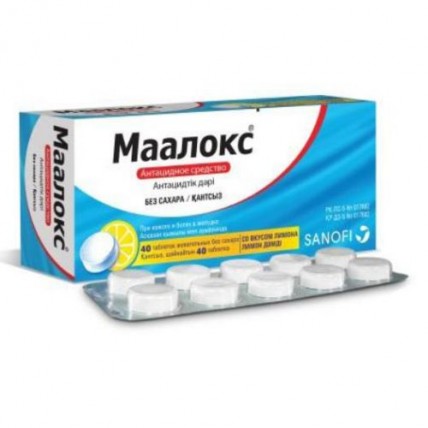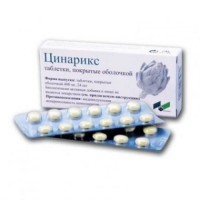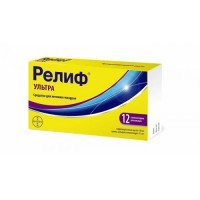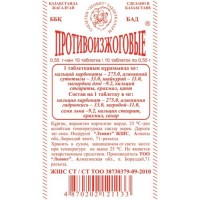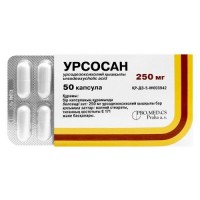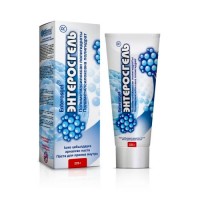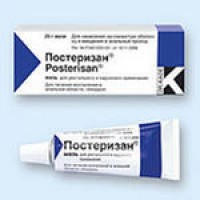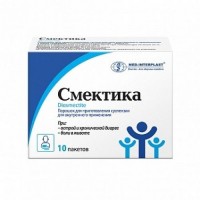The instruction for medical use
of Maaloks medicine
the Trade name
of Maaloks
the International non-proprietary name
Is not present
the Dosage form
chewable tablets without sugar
Structure
One tablet contains:
active agents: aluminum the oxide hydrated 400.0 mg (it is equivalent to aluminum to oxide 200.0), magnesium hydroxide of 400 mg,
excipients: the sorbitol solution which is not crystallizing
(it is equivalent to sorbitol), maltit, glycerin of 85% (it is equivalent to glycerin), magnesium stearate, lemon fragrance, sodium saccharin, talc, water purified.
The description
Round chewable tablets from white till yellowish color with an engraving of MAALOX on the one hand and sans sucre on other party with a lemon smell.
Pharmacotherapeutic group
Drugs for treatment of the diseases connected with disturbance of acidity. Combination of drugs of aluminum, calcium and magnesium. Simple combination of salts.
The ATX A02AD01 code
the Pharmacological
Pharmacokinetics Hydroxides properties of magnesium and aluminum - locally acting, non-systemic antiacid means which absorption is insignificant under normal conditions uses. Maaloks chewable tablets without sugar are badly soaked up from digestive tract. In the course of neutralization the ions of magnesium and aluminum are released in insignificant degree. Generally they turn into almost insoluble phosphates during passing through intestines and are removed in such view with excrements. A number of ions of magnesium and aluminum are soaked up that leads to temporary increase in concentration of aluminum in blood plasma and to increase in its renal excretion. Aluminum levels in blood plasma remain lower than the range of toxicity and return to normal values within 3-5 days after the treatment termination. The small fraction of magnesium is soaked up. Concentration of magnesium in blood plasma, as a rule, remain constants owing to removal by kidneys. In cases of a renal failure and long reception of high doses can take place a gipermagniyemiya and even intoxication magnesium, besides, aluminum deposits, especially in a nervous and bone tissue can gradually be formed.
The pharmacodynamics
of Maaloks protects a mucous membrane of a gullet, a stomach and a duodenum. Effect of aluminum hydroxides and magnesium is based on neutralization of hydrochloric acid of gastric juice. Hydroxides of aluminum and magnesium are differently active concerning acid. Magnesium hydroxide leads to fast and short-term increase intragastric rn out of limits of physiological values (rn 7-8) while aluminum hydroxide is insufficiently active for independent use. The combination of both hydroxides leads to long binding of protons which total amount is equal to total number of ions of aluminum and magnesium. Hydroxides of magnesium and aluminum affect sokratitelny ability of intestines in various ways. Magnesium hydroxide possesses laxative action whereas aluminum hydroxide leads to a constipation. Maaloks we penetrate for X-rays. The general antiacid ability of one dose (titration at rn 1) is 14.71 mmol of H+ (by the Vatier method).
Indications
- heartburn and an acid eructation at adults and children from 15-summer age
the Route of administration and doses
Children from 15-year age and adults:
On 1-2 tablets to rassasyvat or chew in heartburn and an acid eructation.
The maximum quantity of doses in day: 6 doses (1 dose may contain 1-2 tablets, therefore, 6 doses x 1-2 tablets = 6 - 12 tablets a day).
It is not necessary to take more than 12 pill a day.
At preservation of symptoms or their strengthening after 10 days of treatment of Maaloksom it is necessary to find out the reason and to reconsider treatment.
By-effects
- disturbances of transit in digestive tract (diarrhea or a constipation)
- a hypophosphatemia after long use or after high doses of drug because of aluminum content in this drug. The easy form of a hypophosphatemia proceeds asymptomatically, expressed leads to damage of bones.
Contraindications
- hypersensitivity to any of drug components
- a heavy renal failure (clearance of creatinine ˂ 30 ml/min. / 1.73 sq.m) as drug contains magnesium and aluminum
Medicinal interactions
At simultaneous use with antacids is observed decrease in gastrointestinal absorption of other medicines. For precaution between reception of antacids and other drugs the interval is allowed. As far as possible, the interval has to make more than 2 hours between reception of Maaloksa® and acetylsalicylic acid, anti-secretory H2 of antihistaminic drugs, atenolol, biphosphonates, cation exchanger of sodium sulphonate, chloroquine, tsiklin, digitalis glycosides, Ethambutolum, a feksofenadin of iron (salt), fluorine, ftorkhinolon, glucocorticoids, except therapy on substitution of a hydrocortisone (it is described for Prednisolonum and dexamethasone), thyroid hormones, indometacin, an isoniazid, ketokonazol (reduced gastrointestinal absorption of a ketokonazol because of raised gastric rn), a lansoprazola, linkosamida, metoprolol, fenotiazinovy neuroleptics, phosphorus (additives), propranolol, Sulpiridum.
Combinations which need to be taken into account:
With a renal failure the joint reception with citrates can cause the increased aluminum levels in blood in patients.
Ulipristal: action of an ulipristal can be reduced because of the lowered absorption.
Special instructions
Patients need to see a doctor in a case:
- decrease in body weight
- difficulties when swallowing or the remaining feeling of discomfort in a stomach,
- the digestive disturbances which arose for the first time or recent changes in the existing disorders
- a renal failure.
Precautionary measures at use
For patients with a renal failure or at being on dialysis it is necessary to consider consumption of salts of aluminum and magnesium. Long intake of these salts in high doses can become the reason of development of encephalopathy, dementia, microcytic anemia or to aggravate the osteomalacy caused by dialysis.
The patients with a porphyria who are on a hemodialysis can have a dangerous intake of aluminum hydroxide.
It is not recommended to patients with intolerance of fructose (rare hereditary disease) as contains sorbitol.
If complaints remain within 10 days of treatment, or deterioration is observed, additional inspection and revision of tactics of treatment is necessary.
At patients with a renal failure the concomitant use with citrates can lead to the increased aluminum levels in plasma (see. Medicinal interactions).
Pregnancy and the period of a lactation
during pregnancy the drug can be taken only in case of need. The doctor solves a possibility of use of Maaloks at pregnancy individually. It is necessary to avoid prolonged use and high doses of drug. During treatment it is possible to continue feeding by a breast.
This medicine contains ions of aluminum or magnesium which can influence transit of food on digestive tract that has to be taken into account. Salts of magnesium hydroxide can cause diarrhea. Salts of aluminum can cause the constipation often observable during pregnancy. Intake of this medicine and in high doses needs to be avoided for a long time.
During treatment it is possible to continue feeding by a breast.
Features of influence of medicine on ability to run the vehicle or potentially dangerous mechanisms
the Overdose does not influence
the Oral overdose of magnesium does not cause toxic reactions in patients with normal function of kidneys. At patients with a heavy renal failure the poisoning with magnesium can develop (see the section Special Instructions).
Toxic effects depend on concentration of magnesium in serum. Signs of toxic effect is the following: the lowered blood pressure, nausea, vomiting, dizziness, reduced reflexes, muscular fatigue, neuromuscular paralysis, bradycardia, disturbances in the ECG, hypoventilation, in the most serious cases, respiratory paralysis, a coma, failure of kidneys or cardiac arrest, an anuretic syndrome.
Magnesium overdose treatment: effects of a gipermagneziyemiya can be eliminated by intravenous reception of a gluconate of calcium. At patients with a renal failure the hemodialysis or peritoneal dialysis is necessary.
A form of release and packing
On 10 tablets in blister strip packaging from a film of polyvinylchloride/polyvinylidene chloride and aluminum foil.
On 4 blister strip packagings together with the instruction for medical use in the state and Russian languages put in a cardboard pack.
To Store storage conditions at
a temperature not higher than 25 S. Hranit out of children's reach!
3 years
not to apply a period of storage after expiry date.
Prescription status
Without prescription
the Producer/packer
S.P.A. Sanofi-aventis, Italy
SS 17 KM 22 – 67019 SCOPPITO (AQ), Italy
the Owner of the registration certificate
S.P.A. Sanofi-aventis, Italy
the Address of the organization accepting in the territory of the Republic of Kazakhstan claims from consumers on quality of products (goods) 050013 Almaty, Furmanov St. 187 phone: 8-727-244-50-96факс: 8-727-258-26-96e-mail:
To Develop quality.info@sanofi.com
of Maaloks medicine
the Trade name
of Maaloks
the International non-proprietary name
Is not present
the Dosage form
chewable tablets without sugar
Structure
One tablet contains:
active agents: aluminum the oxide hydrated 400.0 mg (it is equivalent to aluminum to oxide 200.0), magnesium hydroxide of 400 mg,
excipients: the sorbitol solution which is not crystallizing
(it is equivalent to sorbitol), maltit, glycerin of 85% (it is equivalent to glycerin), magnesium stearate, lemon fragrance, sodium saccharin, talc, water purified.
The description
Round chewable tablets from white till yellowish color with an engraving of MAALOX on the one hand and sans sucre on other party with a lemon smell.
Pharmacotherapeutic group
Drugs for treatment of the diseases connected with disturbance of acidity. Combination of drugs of aluminum, calcium and magnesium. Simple combination of salts.
The ATX A02AD01 code
the Pharmacological
Pharmacokinetics Hydroxides properties of magnesium and aluminum - locally acting, non-systemic antiacid means which absorption is insignificant under normal conditions uses. Maaloks chewable tablets without sugar are badly soaked up from digestive tract. In the course of neutralization the ions of magnesium and aluminum are released in insignificant degree. Generally they turn into almost insoluble phosphates during passing through intestines and are removed in such view with excrements. A number of ions of magnesium and aluminum are soaked up that leads to temporary increase in concentration of aluminum in blood plasma and to increase in its renal excretion. Aluminum levels in blood plasma remain lower than the range of toxicity and return to normal values within 3-5 days after the treatment termination. The small fraction of magnesium is soaked up. Concentration of magnesium in blood plasma, as a rule, remain constants owing to removal by kidneys. In cases of a renal failure and long reception of high doses can take place a gipermagniyemiya and even intoxication magnesium, besides, aluminum deposits, especially in a nervous and bone tissue can gradually be formed.
The pharmacodynamics
of Maaloks protects a mucous membrane of a gullet, a stomach and a duodenum. Effect of aluminum hydroxides and magnesium is based on neutralization of hydrochloric acid of gastric juice. Hydroxides of aluminum and magnesium are differently active concerning acid. Magnesium hydroxide leads to fast and short-term increase intragastric rn out of limits of physiological values (rn 7-8) while aluminum hydroxide is insufficiently active for independent use. The combination of both hydroxides leads to long binding of protons which total amount is equal to total number of ions of aluminum and magnesium. Hydroxides of magnesium and aluminum affect sokratitelny ability of intestines in various ways. Magnesium hydroxide possesses laxative action whereas aluminum hydroxide leads to a constipation. Maaloks we penetrate for X-rays. The general antiacid ability of one dose (titration at rn 1) is 14.71 mmol of H+ (by the Vatier method).
Indications
- heartburn and an acid eructation at adults and children from 15-summer age
the Route of administration and doses
Children from 15-year age and adults:
On 1-2 tablets to rassasyvat or chew in heartburn and an acid eructation.
The maximum quantity of doses in day: 6 doses (1 dose may contain 1-2 tablets, therefore, 6 doses x 1-2 tablets = 6 - 12 tablets a day).
It is not necessary to take more than 12 pill a day.
At preservation of symptoms or their strengthening after 10 days of treatment of Maaloksom it is necessary to find out the reason and to reconsider treatment.
By-effects
- disturbances of transit in digestive tract (diarrhea or a constipation)
- a hypophosphatemia after long use or after high doses of drug because of aluminum content in this drug. The easy form of a hypophosphatemia proceeds asymptomatically, expressed leads to damage of bones.
Contraindications
- hypersensitivity to any of drug components
- a heavy renal failure (clearance of creatinine ˂ 30 ml/min. / 1.73 sq.m) as drug contains magnesium and aluminum
Medicinal interactions
At simultaneous use with antacids is observed decrease in gastrointestinal absorption of other medicines. For precaution between reception of antacids and other drugs the interval is allowed. As far as possible, the interval has to make more than 2 hours between reception of Maaloksa® and acetylsalicylic acid, anti-secretory H2 of antihistaminic drugs, atenolol, biphosphonates, cation exchanger of sodium sulphonate, chloroquine, tsiklin, digitalis glycosides, Ethambutolum, a feksofenadin of iron (salt), fluorine, ftorkhinolon, glucocorticoids, except therapy on substitution of a hydrocortisone (it is described for Prednisolonum and dexamethasone), thyroid hormones, indometacin, an isoniazid, ketokonazol (reduced gastrointestinal absorption of a ketokonazol because of raised gastric rn), a lansoprazola, linkosamida, metoprolol, fenotiazinovy neuroleptics, phosphorus (additives), propranolol, Sulpiridum.
Combinations which need to be taken into account:
With a renal failure the joint reception with citrates can cause the increased aluminum levels in blood in patients.
Ulipristal: action of an ulipristal can be reduced because of the lowered absorption.
Special instructions
Patients need to see a doctor in a case:
- decrease in body weight
- difficulties when swallowing or the remaining feeling of discomfort in a stomach,
- the digestive disturbances which arose for the first time or recent changes in the existing disorders
- a renal failure.
Precautionary measures at use
For patients with a renal failure or at being on dialysis it is necessary to consider consumption of salts of aluminum and magnesium. Long intake of these salts in high doses can become the reason of development of encephalopathy, dementia, microcytic anemia or to aggravate the osteomalacy caused by dialysis.
The patients with a porphyria who are on a hemodialysis can have a dangerous intake of aluminum hydroxide.
It is not recommended to patients with intolerance of fructose (rare hereditary disease) as contains sorbitol.
If complaints remain within 10 days of treatment, or deterioration is observed, additional inspection and revision of tactics of treatment is necessary.
At patients with a renal failure the concomitant use with citrates can lead to the increased aluminum levels in plasma (see. Medicinal interactions).
Pregnancy and the period of a lactation
during pregnancy the drug can be taken only in case of need. The doctor solves a possibility of use of Maaloks at pregnancy individually. It is necessary to avoid prolonged use and high doses of drug. During treatment it is possible to continue feeding by a breast.
This medicine contains ions of aluminum or magnesium which can influence transit of food on digestive tract that has to be taken into account. Salts of magnesium hydroxide can cause diarrhea. Salts of aluminum can cause the constipation often observable during pregnancy. Intake of this medicine and in high doses needs to be avoided for a long time.
During treatment it is possible to continue feeding by a breast.
Features of influence of medicine on ability to run the vehicle or potentially dangerous mechanisms
the Overdose does not influence
the Oral overdose of magnesium does not cause toxic reactions in patients with normal function of kidneys. At patients with a heavy renal failure the poisoning with magnesium can develop (see the section Special Instructions).
Toxic effects depend on concentration of magnesium in serum. Signs of toxic effect is the following: the lowered blood pressure, nausea, vomiting, dizziness, reduced reflexes, muscular fatigue, neuromuscular paralysis, bradycardia, disturbances in the ECG, hypoventilation, in the most serious cases, respiratory paralysis, a coma, failure of kidneys or cardiac arrest, an anuretic syndrome.
Magnesium overdose treatment: effects of a gipermagneziyemiya can be eliminated by intravenous reception of a gluconate of calcium. At patients with a renal failure the hemodialysis or peritoneal dialysis is necessary.
A form of release and packing
On 10 tablets in blister strip packaging from a film of polyvinylchloride/polyvinylidene chloride and aluminum foil.
On 4 blister strip packagings together with the instruction for medical use in the state and Russian languages put in a cardboard pack.
To Store storage conditions at
a temperature not higher than 25 S. Hranit out of children's reach!
3 years
not to apply a period of storage after expiry date.
Prescription status
Without prescription
the Producer/packer
S.P.A. Sanofi-aventis, Italy
SS 17 KM 22 – 67019 SCOPPITO (AQ), Italy
the Owner of the registration certificate
S.P.A. Sanofi-aventis, Italy
the Address of the organization accepting in the territory of the Republic of Kazakhstan claims from consumers on quality of products (goods) 050013 Almaty, Furmanov St. 187 phone: 8-727-244-50-96факс: 8-727-258-26-96e-mail:
To Develop quality.info@sanofi.com
